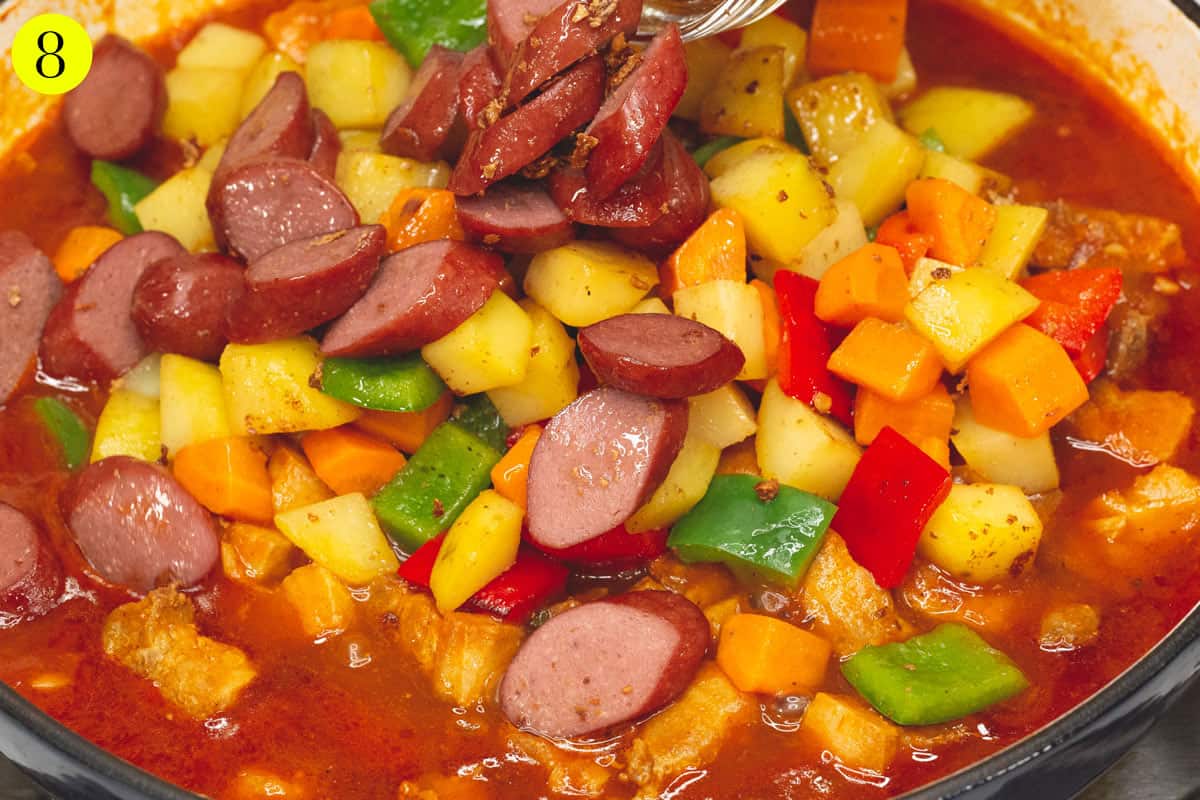Filipino Menudo is a hearty stew with pork, a medley of vegetables, and hotdogs in a tomato-based sauce. It has a balance of savory and sweet flavors, perfect for anyone looking to try a classic Filipino comfort food.

Jump to:
Ingredients you'll need

Notes and substitutions
- Pork: I used skinless pork belly for flavor and moisture. Pork shoulder or pork tenderloin are leaner options; adjust cooking times as tenderloin cooks faster. Cut them into larger bite-sized pieces; they shrink as they cook. Adding pork or chicken liver is optional.
- Vegetables: I used carrots, bell peppers, and potatoes—preferably Yukon Gold or red potatoes, as they hold their shape well during cooking. Cut them evenly and slightly smaller than the meat. Feel free to add garbanzo beans or chickpeas for an extra layer of texture and flavor.
- Tomato paste: It is dense and concentrated with a deep tomato flavor. If you want to use tomato sauce instead, use less water in the recipe.
- Raisins: Some may not like raisins in savory recipes, but they add a nice, sweet touch. Not a raisin fan? No problem, just leave them out, but consider giving them a try—you might like it!
How to make this recipe
Step 1: Prepare pork
Slice the pork belly into slightly large bite-sized pieces; they'll shrink when cooked. Season them lightly with salt.

Step 2: Sear meat
Set a sauté pan or a wide, heavy-bottomed pot over medium-high heat and add a light coating of oil. Spread the pork pieces in the pan and let them sear without disturbing them initially; this helps achieve a light brown crust and avoids steaming.
Please be mindful of any splatter during this process. Once they start to sizzle, stir them for even browning, then transfer them to a plate. Remove any excess oil in the pan.
PRO TIP: Sear the pork, hotdogs, and sturdy vegetables first. This Maillard reaction, achieved by cooking on high heat until browned, not only caramelizes the surface but also adds so much flavor to the dish. Avoid overcrowding for even searing.

Step 3: Sear hotdogs
Quickly sear the sliced hotdogs, just enough to achieve a slightly caramelized exterior. Though they are usually pre-cooked, doing so makes them taste better. Transfer them to a plate.

Step 4: Sear vegetables
Sear the potatoes and carrots until they develop a light crust. Turn them occasionally for even browning. Add in the bell peppers and give them a quick sear. Transfer them to a plate.

Step 5: Sauté aromatics
Lower the heat to medium and add a bit more oil if needed. Sauté the onions, stirring occasionally, until they become translucent. Add the garlic and continue to sauté until aromatic.

Step 6: Brown tomato paste
Add the tomato paste and cook for about 2 minutes until it caramelizes and deepens in color. Stir constantly.

Step 7: Add ingredients and simmer
Bring the meat back, then add the raisins, bay leaves, water, chicken base or bouillon, fish sauce, and sugar. Add some ground pepper to taste.
Mix them while scraping the fond or browned bits on the bottom. Turn up the heat and bring the mixture to a boil.
Then, cover and simmer on medium heat for 20-30 minutes or until the meat is tender. Add more liquid as necessary.

Step 8: Add vegetables and hotdogs
Add the vegetables and hotdogs, then let them cook for 5-10 minutes or until the vegetables are tender. Taste the sauce at this point and make adjustments as needed.

Step 9: Add peas
Stir in the peas and let them cook for about a minute or just until they are heated through to maintain their vibrant color. Turn off the heat.

Before serving, remember to remove the bay leaves. Filipino Menudo is best enjoyed warm over a bed of steaming rice to soak up all the delicious flavors.

Recipe FAQs
Filipino Menudo is a savory, hearty stew traditionally made with diced pork, liver, potatoes, carrots, and bell peppers. It is simmered in a rich tomato-based sauce, often with a hint of sweetness from raisins. This dish is distinct from Mexican Menudo, a soup made with beef tripe.
Yes. Although pork is the traditional choice, substituting it with chicken or beef is perfectly fine—just modify the cooking times as needed.
Absolutely! While liver adds a distinct richness and depth of flavor to the dish, it's not to everyone's taste. I skipped it in my recipe, and it still turned out delicious. So, if you're not a fan, feel free to leave it out!
Try other Filipino braises and stews
- Picadillo: A stew of ground beef or pork, potatoes, and carrots, simmered in a tomato-based sauce.
- Guisantes: A simple dish of green peas and pork, cooked with tomato sauce and bell peppers.
- Kare-Kare: A savory peanut stew typically made with oxtail, vegetables, and a thick peanut sauce, served with fermented shrimp paste (bagoong) on the side.
- Caldereta: A hearty beef stew cooked with potatoes, carrots, bell peppers, and liver spread in a thick tomato sauce.
- Bicol Express: A spicy and creamy dish with pork, coconut milk, and plenty of chili peppers.
- Pork Binagoongan: A savory pork dish cooked in shrimp paste (bagoong), often accompanied by eggplant.
- Humba: A sweet and savory pork stew from the Visayas with salted black beans, pineapple, and dried banana blossoms.
Other pork recipes you may like

Did you make this recipe? I would love to know! Your feedback helps me make better recipes. Please rate, review, or comment below. Questions about this recipe are welcome, too!
Let's connect on Facebook, Instagram, Pinterest, TikTok, Twitter, and Youtube. Be sure to tag me when you try any of my recipes @recipesbynora!
📖 Recipe

Filipino Menudo
Equipment
- Sauté pan or a wide, heavy-bottomed pot
Ingredients
- 2 pounds pork belly sliced into large bite-sized pieces (see note)
- 3 pieces hotdogs sliced diagonally
- 2 cups diced potatoes (see note)
- 1 cup diced carrots
- ½ red bell pepper diced
- ½ green bell pepper diced
- 1 medium onion finely chopped
- 6 garlic minced
- ½ cup tomato paste (see note)
- ½ cup raisins (see note)
- 2 bay leaves
- 3 cups water more as needed
- 2 teaspoons chicken base or bouillon
- 1 tablespoon fish sauce or soy sauce adjust to taste
- 1 tablespoon sugar adjust to taste
- ½ cup frozen peas
- Salt and pepper to taste
- Neutral oil (for searing and sautéing)
Instructions
- Prepare the Pork: Slice the pork belly into slightly large bite-sized pieces; they'll shrink when cooked. Season them lightly with salt.
- Sear the Meat: Set a sauté pan or a wide, heavy-bottomed pot over medium-high heat and add a light coating of oil. Spread the pork pieces in the pan and let them sear without disturbing them initially; this helps achieve a light brown crust and avoids steaming.Please be mindful of any splatter during this process. Once they start to sizzle, stir them for even browning, then transfer them to a plate. Remove any excess oil in the pan.
- Sear the Hotdogs: Quickly sear the sliced hotdogs, just enough to achieve a slightly caramelized exterior. Though they are usually pre-cooked, doing so makes them taste better. Transfer them to a plate.
- Sear the Vegetables: Sear the potatoes and carrots until they develop a light crust. Turn them occasionally for even browning. Add in the bell peppers and give them a quick sear. Transfer them to a plate.
- Sauté the Aromatics: Lower the heat to medium and add a bit more oil if needed. Sauté the onions, stirring occasionally, until they become translucent. Add the garlic and continue to sauté until aromatic.
- Brown the Tomato Paste: Add the tomato paste and cook for about 2 minutes until it caramelizes and deepens in color. Stir constantly.
- Add Ingredients and Simmer: Bring the meat back, then add the raisins, bay leaves, water, chicken base or bouillon, fish sauce, and sugar. Add some ground pepper to taste. Mix them while scraping the fond or browned bits on the bottom. Turn up the heat and bring the mixture to a boil. Then, cover and simmer on medium heat for 20-30 minutes or until the meat is tender. Add more liquid as necessary.
- Add the Vegetables and Hotdogs: Add the vegetables and hotdogs, then let them cook for 5-10 minutes or until the vegetables are tender. Taste the sauce at this point and make adjustments as needed.
- Add the Peas: Stir in the peas and let them cook for about a minute or just until they are heated through to maintain their vibrant color. Turn off the heat.Before serving, remember to remove the bay leaves. This dish is best enjoyed warm over a bed of steaming rice to soak up all the delicious flavors.
Notes
- Pork: I used skinless pork belly for flavor and moisture. Pork shoulder or pork tenderloin are leaner options; adjust cooking times as tenderloin cooks faster. Cut them into larger bite-sized pieces; they shrink as they cook. Adding pork or chicken liver is optional.
- Vegetables: I used carrots, bell peppers, and potatoes—preferably Yukon Gold or red potatoes, as they hold their shape well during cooking. Cut them evenly and slightly smaller than the meat. Feel free to add garbanzo beans or chickpeas for an extra layer of texture and flavor.
- Tomato paste: It is dense and concentrated with a deep tomato flavor. If you want to use tomato sauce instead, use less water in the recipe.
- Raisins: Some may not like raisins in savory recipes, but they add a nice, sweet touch. Not a raisin fan? No problem, just leave them out, but consider giving them a try—you might like it!











Elizabeth Sambajon
I think the key to menudo is cooking the pork tenderly. I used this recipe without raisins, bc as a child I always hated raisins in my menudo. I used yellow bell pepper instead of red bell pepper. Although, the red bell pepper would have been more tasty, I had to use just what was in my cupboard. And, i modified the amounts of the ingredients a bit. Thank you, Nora.
Nora Reyes
Hi Elizabeth! Thank you for sharing your tweaks on the recipe! I totally agree that getting the pork perfectly tender is crucial—it just makes the dish, and when the fat starts to melt into the sauce, it adds so much flavor. I hear you on the raisins! While I like the touch of sweetness they add to the dish, I'm also not a huge fan of actually eating them, so I often end up pushing them to the side of my plate too. LOL
Using yellow bell pepper instead of red because that’s what you had is such a smart move. It’s all about making the recipe work with what you’ve got, and I love that you did just that. Thanks again for giving the recipe a go and for your thoughtful feedback.
Jomelyn Mauermann
I've tried this recipe and my family love it so much. Thanks alot.
Nora Reyes
Hi Jomelyn, I am so happy to hear that. Thank you so much!!
Jean
Thank you for the detailed instructions. It’s very helpful to a novice cook like me. Thanks a lot!
Nora Rey
Hello Jean, I'm so glad to hear that you found the instructions helpful! If you ever have questions or need clarification on any recipe, feel free to ask. Happy cooking!